What do you do when even your dog won’t eat your math homework?
Eat it yourself, of course! If you’re someone who shudders at the mere mention of fractions, integers, algorithms, formulas and polygons, you’ll be happy to know you can actually eat your way to a better understanding of these concepts and have a lot of fun doing it. 🙂
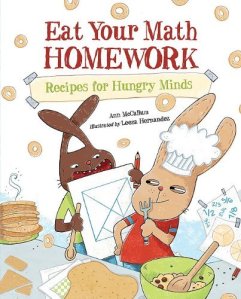 Author Ann McCallum and illustrator Leeza Hernandez, math chefs extraordinaire and creators of the delightfully delectable, Eat Your Math Homework: Recipes for Hungry Minds (Charlesbridge, 2011), are here today to take the lid off the dreaded “fear of mathematics.”
Author Ann McCallum and illustrator Leeza Hernandez, math chefs extraordinaire and creators of the delightfully delectable, Eat Your Math Homework: Recipes for Hungry Minds (Charlesbridge, 2011), are here today to take the lid off the dreaded “fear of mathematics.”
Their charmingly illustrated, yummy collection of edible math projects, served up with generous sides of kitchen tips, fun facts, and chewy appeteasers makes what is often puzzling palatable and transforms numerical drudgery into drool-worthy deliciousness.
Getting past the anxiety of numerators, denominators, diameters and circumferences is as easy as whipping up a batch of Fraction Chips — cutting fried tortillas into equal pieces to share with your friends. Learn about the very cool Fibonacci sequence by skewering the right number of strawberries, marshmallows, grapes or any other favorite snack onto sticks. Yum!

Understanding constants and variables is duck soup when you make your very own Variable Pizza Pi, and don’t even get me started on the Tessellating Two-Color Brownies. Not sure what tessellations are? Chocolate is the answer, my friend. I love how this book shows kids the beauty of math at work in everyday life. Pass me another brownie, please. 🙂
* * *
♥ Q & A WITH ANN AND LEEZA ♥

What kind of student were you? Did you like math growing up?
Ann: I always enjoyed school, but I don’t think my math experience was very good as a child. It was more along the lines of worksheets and memorization. I only fell in love with math as an adult, when I was teaching it to elementary kids. I remember having the ‘ah-ha’ moment in my early twenties (!) that there was actually a pattern for the nine times table! It was incredible and from then on, I started studying how math actually works (rather than simply memorizing it).
Leeza: Happy. I enjoyed school for the most part and was always eager to learn. Art, French and sports were my favorite subjects.
Mathematics was a mixed bag. As I got older it became more challenging for me, but that was okay, I liked the challenge. My high school teacher’s name was Ms. Mountford. I dedicated my portion of the book to her. She had a gentle but firm way of teaching. One of her quotes I’ve never forgotten: “Organization is the key to success.” She was probably referring to my chicken-scratch scrawl I turned in on my homework, but I like to think it applies to life in general, too.
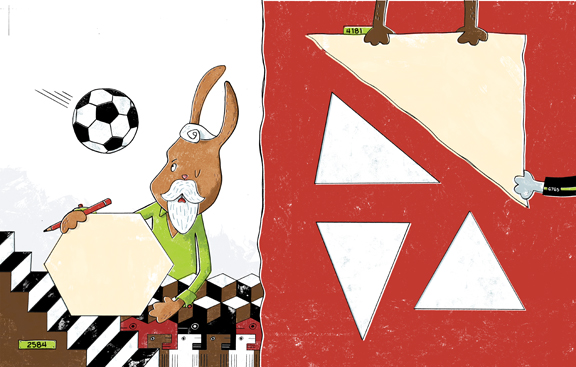
Why do you think math phobia is so common with both kids and adults?
Ann: I think that for many people math isn’t necessarily as natural as words and story. (We grow up needing to talk and craving stories.) It also comes down to early experiences. For teachers (like me) who didn’t have a great math experience themselves, it’s hard to foster enthusiasm in the kids they are teaching. I think this is changing. Math is something you sometimes have to persevere with before you ‘get it’. But, once you do, boy, it is amazing!
Leeza: I wonder if it’s a right brain, left brain thing, but you know what, I’ll leave Ann to answer that one!
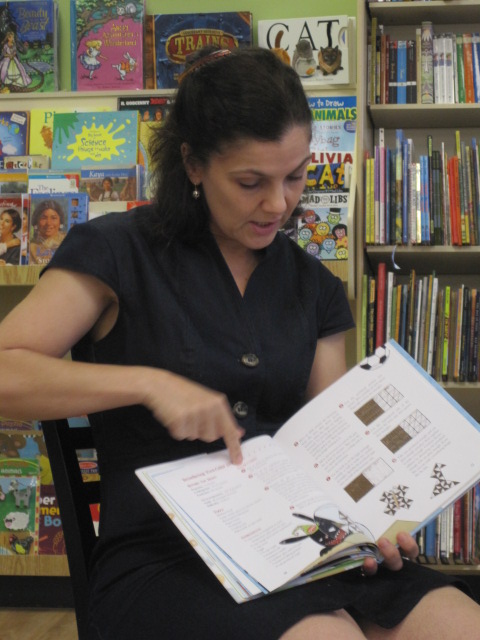
Ann, how did you come up with the idea of writing a children’s book combining math with cooking?
I was teaching elementary school at the time and one year I had the fun idea that I would let my students make mathematical gingerbread houses. You know, the kind made from 4 graham cracker walls with two graham crackers for the roof? There wasn’t much direction—just, add math things such as gumdrops along the perimeter of the roof, a rhombus window maybe, or an icing path of exactly 3 inches. The students were amazing and they loved the project so much, I thought about doing other things with food and math. It took 3 books later before Eat Your Math Homework was born.
Do you both like cooking? If so, what is your specialty?
Ann: I do enjoy cooking and I have to admit that my sweet tooth steers me towards baking. I love to experiment rather than follow a recipe exactly. The other day, for example, I made cookies with pink lemonade powder because I didn’t have enough sugar in the house. (They’re really good—though not all my baking experiments turn out so well!)
Leeza: I LOVE to cook, but confess that I rarely have time to get too elaborate or fancy with meals. I make a traditional chile con carne that I found in a Mexican cookbook, which my family loves (I make a vegetarian version for myself). Actually, I made it while answering your questions. The cold weather calls for it because the chile has a little ‘heat’ to it!
Ann, please tell us how you “eat” math in a typical day. What are some of the ways math and food are related that might not occur to the average person?
It’s been said that ‘math is everywhere’ and this is so true. Of course, they are the obvious things like measuring for recipes or dividing portions. But, how about calculating when a dish will be ready to take from the oven if it needs 12 minutes to cook? Or, estimating the average number of chocolate chips in a cookie. What is too many; how many is too few?
What did you like best about working on this project? Can you briefly describe your process?
Ann: I was excited to write this book because I felt like it was going to be really fun for kids to make the recipes and learn about math at the same time. I just felt like it was a wonderful way to entice children into loving math.
This is kind of a ‘chicken and egg’ question. I’m trying to think if it was the math first or the recipe first, and I guess it was sometimes one way and other times, the other way. Mostly, I think I thought of how to show probability with food or fractions or another math concept. Then, I thought of a food type that would show this—cookies, pizza, snacks, etc. I spent many hours in the kitchen creating the original recipes. Sometimes they didn’t work out and I had to start from scratch!
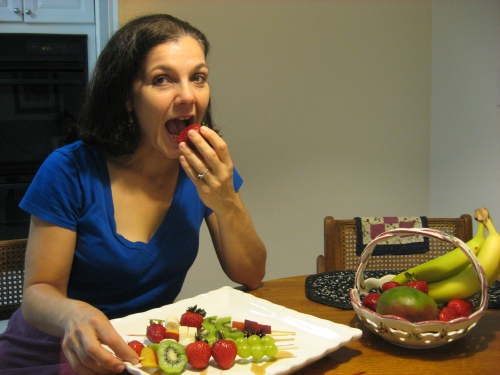
Leeza: Getting to know the rabbits when I was working on the art. And — when the book was done — getting to know Ann. We collaborated on marketing the book, creating the website and doing school visits together. She’s a dear friend and I have loved working with her and getting to know her.
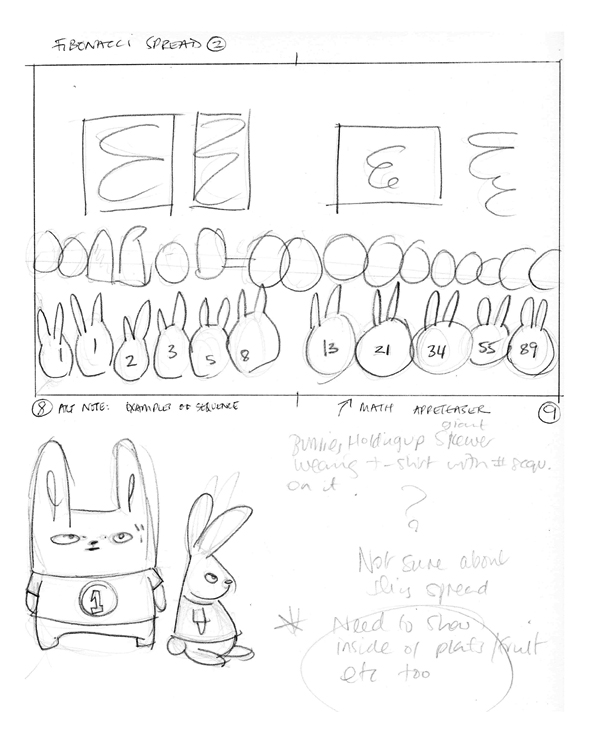
When I read the Fibonacci snack sticks recipe and learned about how Fibonacci discovered his famous number sequence, that’s when the rabbits idea came to me. They wouldn’t leave me alone after that. They’re quite demanding you know!
When I first started working on sketches, I thought that the rabbits would be considered too young for the book- they were more like little fluffy bunnies at the time. I did some research and tried to redo the art using human child characters but it didn’t work at all. Instincts told me to go back to the bunnies but I made them a little older, more tween-like. I’m glad I did, I love the rabbits now.
I read the manuscript a number of times before I do anything. If any immediate images come to mind, I’ll doodle the ideas directly onto the manuscript. Then I put it away and let the text digest for a while. After a week or two, I re-read the text and begin to sketch up more solid images, but at this point, it’s all random. Nothing is in sequence yet. Figuring out the main characters comes next and then I jump into a storyboard. I pin my sketches on my wall and spend my mornings with coffee standing back and figuring out the general flow and pacing of the pages. I want to make sure my compositions are varied, meaning I don’t want every spread to look like the one before it. This can take several weeks to get right, sometimes months.
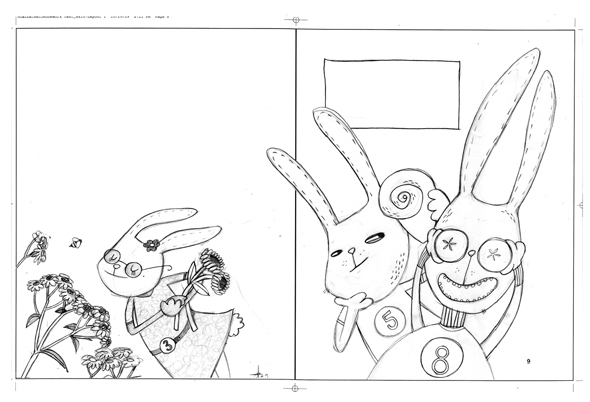
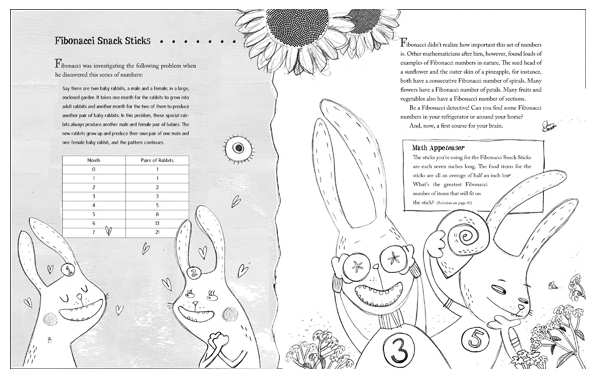
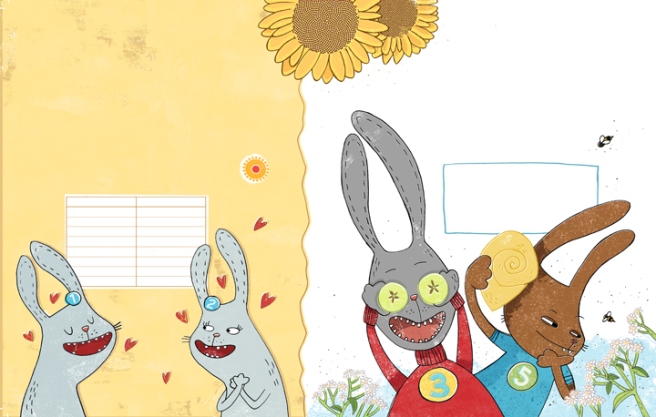
When I am happy I create a neater version of my sketched dummy and send it to the publisher. They send back notes. I make revisions and send again. Once all revisions have been approved I jump into creating final art. Last-minute tweaks are sometimes made to the color art but then I am pretty much done. it’s usually when I am working on final color for the interior that I also begin working up sketches for a cover. So far, all the books I have worked on, the cover has come last.
What’s your favorite recipe from the book? Which recipe do most kids like best?
Ann: The one I always bring to author events is the ‘Tessellating Two-Color Brownies’. First, they are yummy—secret ingredient is . . .—oh, I guess I’d better not give that one away! Also, they look really pretty and the concept, tessellation, is easy for people to get right away. Plus, it’s a word that people have heard but sometimes have forgotten the meaning of. They can understand the concept immediately and feel good about it. Food and math is all about feeling good!
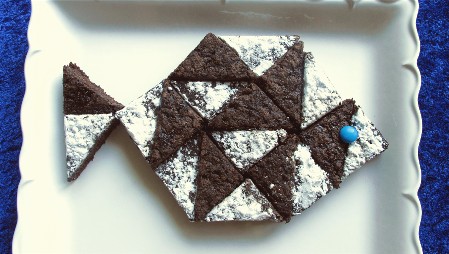
Leeza: Oooh, that’s tough because I love them all! I do enjoy the probability trail mix. It’s so easy to make and when I work in my studio I snack all the time. What I love about that recipe is that I can make my ingredients variable — it’s different every time depending on what’s in my pantry. The Fib snack sticks are awesomesauce too!
Ann, did Leeza’s illustrations come close to what you had envisioned for the book? How would you describe her art to someone who has never seen this book?
I was thrilled to see Leeza’s illustrations, and to see how the book came together after I supplied my words. It’s an amazing process. I didn’t know Leeza ahead of time, but now that I do, it’s all I can do to not beg her to let me see the illustrations for the sequel Eat Your Science Homework: Recipes for Inquiring Minds. (She’s working on rough sketches now.) I really didn’t know what to expect from Leeza’s art, but any expectations I did have were surpassed by Leeza’s wonderful pictures.
Hmmm, to describe Leeza’s art, I would use words like: fun-loving, energetic (like Leeza herself!), intelligent, hilarious. She did a terrific job embedding the math concepts in her art as well.
Ann, do you have any tips for writing kid friendly recipes or cookbooks in general?
I like to think about the kinds of food kids like and then I experiment and think about how the recipe ties into the concept I’m aiming for (i.e., the lemonade cookies I described earlier). I try to keep the number of ingredients down and make sure that there is nothing so complicated that if you don’t follow the directions exactly, it won’t work. I also try things many times before I’m satisfied that it is a terrific recipe and worth including in a book.
Leeza, do you have any tips for illustrating cookbooks? Did you do any delicious culinary “research” to help you create the pictures?
Always do the research. Even if you think you know what broccoli looks like, sit and draw some in front of you first. Naturally I had to test every recipe first and make sure it was delicious enough for me to draw.
Describe the school visits you do together.
Ann: Leeza and I make a great pair, if I do say so myself! I love her energy and while I tend to plan carefully, she brings enthusiasm and spontaneity to our presentations which is always fun and a big hit with the kids. The responses from children are the best part of live performances like this.
Please share a favorite childhood food memory.
Ann: My mom used to make the most amazing birthday cakes. One year I had a Raggedy Ann cake and another year it was a Barbie Cake with a real Barbie in the middle of her cake skirt. I remember the towering rocket cake she made for my brother. She kept it from toppling with a couple of knitting needles pushed down the middle. So, maybe that’s where it all started!
Leeza: In elementary school we had our school lunches in the assembly hall. There was a certain dish each day–entree and dessert with a drink. My favorite dessert was mint custard on chocolate rice crispy cakes — yummy. The dish that I could never bring myself to eat was liver (shudder!). Christmas Day was always a good foodie memory for me, especially all the trimmings, even though I don’t eat turkey now.
Probability Mash-up:
1) What’s the likelihood of another “Eat Your Homework” book?
Ann: There is another book in progress now called Eat Your Science Homework: Recipes for Hungry Minds. I’ve done my part and now Leeza is busy doing the artwork for it. I can’t wait!
Leeza: The rabbits tell me to be on the lookout… They’re heading to the lab for some tasty science next!
2) What are the chances that hundreds of rabbits will move in with you?
Ann: There are certainly hundreds of rabbits in my neighborhood, but I’m happy to visit them outside in my yard versus in my living room!
Leeza: I feel like they already do at my place. In fact, between you and me I think they won’t leave.
3) Is it likely that after trying the recipes in your book, the average kid will change his mind about liking math?
Ann: I hope so. After all, the whole idea is to show people that math truly is delicious.
Leeza: What’s not to love about eating your own homework and learning about math in the process? And from what I’ve seen with the hungry young minds I have met so far, they love it too. Delicious!
Anything else you’d like to add about Eat Your Math Homework?
Ann: Just that the idea of the book is to have fun with math, to see that math isn’t so scary, and that math is such an everyday part of our lives, we should hug it close instead of shying away from it. We have a website that includes a teacher’s guide of extra activities, too: www.eatyourmathhomework.com
Leeza: It’s a flavorful book that doesn’t go bad?! (Okay, don’t groan, the bunnies’ joke, not mine. But I agree it’s filled with yummy recipes that equal tasty results time after time!)
 I never thought I would still be using math today when I create illustrations, but when I work on children’s books, I need to be aware of the technical layout of the book — and pay special attention to trim sizes, margins, and gutters (the fold in the middle of the book). When I start with rough thumbnails of the book, like a story board, I work small. It’s important for me to keep everything in proportion, so being able to calculate percentages comes in handy. I’m always reminding myself to measure twice! (I have a cheat sheet now which is close to my art table at all times.)
I never thought I would still be using math today when I create illustrations, but when I work on children’s books, I need to be aware of the technical layout of the book — and pay special attention to trim sizes, margins, and gutters (the fold in the middle of the book). When I start with rough thumbnails of the book, like a story board, I work small. It’s important for me to keep everything in proportion, so being able to calculate percentages comes in handy. I’m always reminding myself to measure twice! (I have a cheat sheet now which is close to my art table at all times.)
What’s next for you?
Ann: I am working on another couple of projects. One math-related and two not. I am working on a novel, actually, which is a big change for me. It’s a lot of fun, but very different from writing my other books.
Leeza: I’m very excited about a book that’s coming out in the Fall that I illustrated. It’s written by John Lithgow — I just love his books. I’m also working on sketches for two books, one is a companion book to “Dog Gone!” which I wrote and illustrated called “Cat Napped”, and the other book is “Eat Your Science Homework” of course!
* * *
EAT YOUR MATH HOMEWORK: Recipes for Hungry Minds
written by Ann McCallum
illustrated by Leeza Hernandez
published by Charlesbridge, 2011
Cookbook/Activity Book for ages 7+, 46 pp.
* Includes Math Review and Glossary
** Milk mustaches optional 🙂
* * *
♥ SECONDS AND THIRDS ♥
♥ Ann McCallum’s Official Website
♥ Leeza Hernandez’s Official Website
♥ Eat Your Math Homework Website: Don’t miss the great Teacher’s Guide, Jokes, Bonus Recipe and Coloring Pages!
♥ The recipe for Tessellating Two-Color Brownies can be found at the PBS Parents blog.
♥ See a TV interview with Ann here.
———————————————–
* Spreads posted by permission of the illustrator, text copyright © 2011 Ann McCallum, illustrations © 2011 Leeza Hernandez, published by Charlesbridge. All rights reserved.
Copyright © 2013 Jama Rattigan of Jama’s Alphabet Soup. All rights reserved.

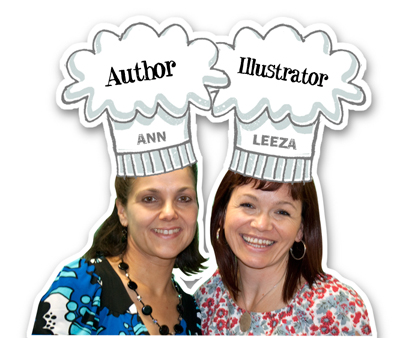
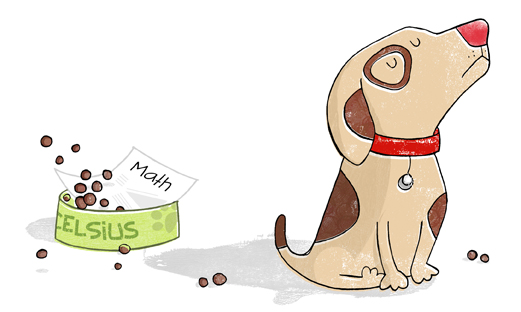
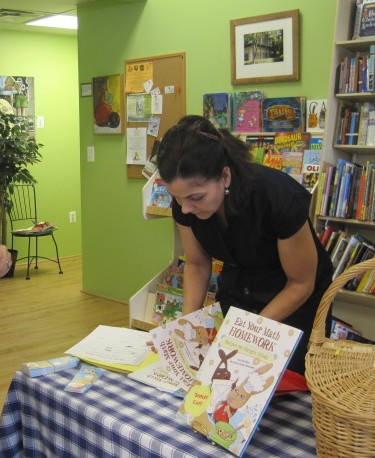
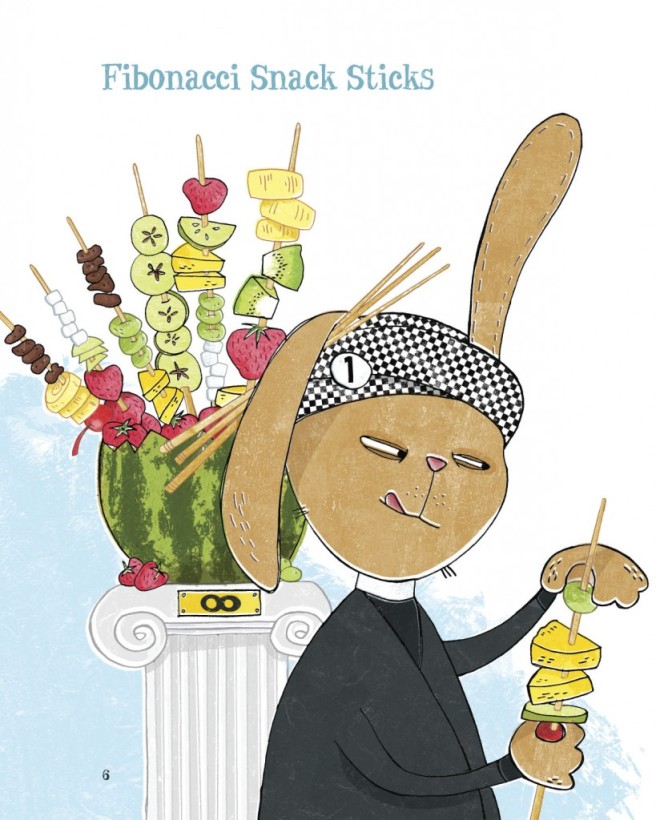

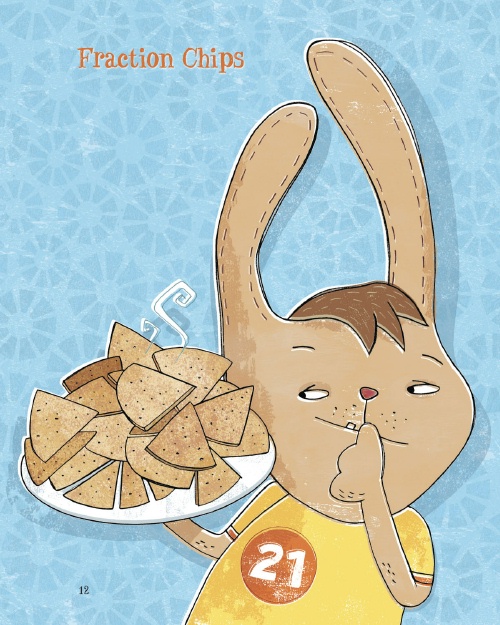
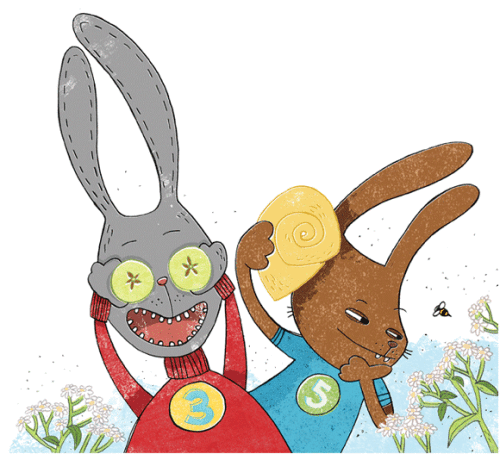
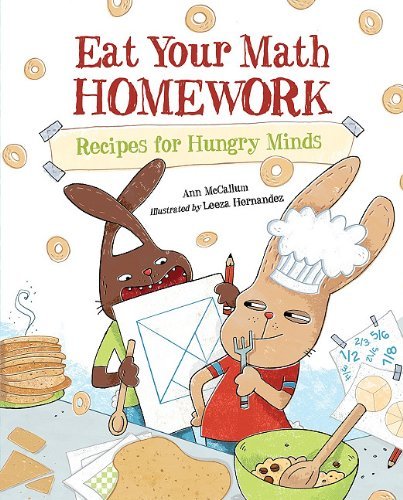
Love this!! Putting this on my list!!
LikeLike
Yay!! Do you, by any chance, know Ann from area conferences, etc.?
LikeLike
This looks terrific, Jama. I will send the book idea on to all my colleagues. I love the tangram cookies, have done (in the past) lots of work with tessellations-am now sorry I didn’t think of food ones! The book look filled with wonderful ideas! Thanks to all of you!
LikeLike
Thanks for letting your colleagues know about this book, Linda. It’s a very user friendly book — recipes clear and nicely laid out, and following the rabbits from page to page is sheer delight.
LikeLike
My daughter tried some of these recipes when the book first pubbed and my whole family enjoyed them. And on your blog, Jama, it was such fun to see Ann and Leeza in their chef toques. Thanks for sharing this honey of a picture book.
LikeLike
Happy to hear your family liked the recipes :). Proof is in the pudding . . .
LikeLike
What an amazing idea. I hope this book does well. It’s so original.
LikeLike
Yes, very original — and it’s done well enough to justify a sequel. The science recipes will be interesting too. 🙂
LikeLike
I love all of this – makes me wants to teach math to kids and THAT is saying a lot!
I, too, had a Raggedy Ann cake and a Barbie Cake, although it was a knock-off Barbie and the cake decorator actually CUT OFF the doll’s feet to make the ‘skirt’ fit correctly. Traumatized every little girl at my party!
LikeLike
Ack! I’m traumatized just hearing about it. Poor Barbie. Lucky you, I love both Raggedy Ann and Barbie but never had birthday cakes with them on it. Sigh. I still have a very big Raggedy Ann, though, and ironically enough, one of her feet is coming off . . .
LikeLike
Oh, yes, Jama. I need to have this book. I loved the question and answer exchanges. You could feel the fun in the air. Thank you.
LikeLike
I never realized math could taste so good :).
LikeLike